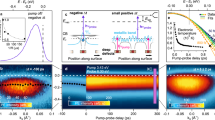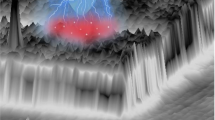Abstract
Strong interactions, or correlations, between the d or f electrons in transition-metal oxides lead to various types of metal–insulator transitions that can be triggered by external parameters such as temperature, pressure, doping, magnetic fields and electric fields. Electric-field-induced metallization of such materials from their insulating states could enable a new class of ultrafast electronic switches and latches. However, significant questions remain about the detailed nature of the switching process. Here, we show, in the canonical metal-to-insulator transition system V2O3, that ultrafast voltage pulses result in its metallization only after an incubation time that ranges from ∼150 ps to many nanoseconds, depending on the electric field strength. We show that these incubation times can be accounted for by purely thermal effects and that intrinsic electronic-switching mechanisms may only be revealed using larger electric fields at even shorter timescales.
This is a preview of subscription content, access via your institution
Access options
Subscribe to this journal
Receive 12 print issues and online access
$259.00 per year
only $21.58 per issue
Buy this article
- Purchase on Springer Link
- Instant access to full article PDF
Prices may be subject to local taxes which are calculated during checkout





Similar content being viewed by others
References
Mott, N. F. Metal Insulator Transitions 2nd edn (Taylor & Francis, 1990).
Imada, M., Fujimori, A. & Tokura, Y. Metal–insulator transitions. Rev. Mod. Phys. 70, 1039–1263 (1998).
Dernier, P. D. & Marezio, M. Crystal structure of the low-temperature antiferromagnetic phase of V2O3 . Phys. Rev. B 2, 3771–3776 (1970).
McWhan, D. B., Menth, A., Remeika, J. P., Brinkman, W. F. & Rice, T. M. Metal–insulator transitions in pure and doped V2O3 . Phys. Rev. B 7, 1920–1931 (1973).
Pfalzer, P., Obermeier, G., Klemm, M., Horn, S. & denBoer, M. L. Structural precursor to the metal–insulator transition in V2O3 . Phys. Rev. B 73, 144106 (2006).
Laad, M. S., Craco, L. & Müller-Hartmann, E. Orbital-selective insulator–metal transition in V2O3 under external pressure. Phys. Rev. B 73, 045109 (2006).
Rodolakis, F. et al. Inequivalent routes across the Mott transition in V2O3 explored by X-ray absorption. Phys. Rev. Lett. 104, 047401 (2010).
Held, K., Keller, G., Eyert, V., Vollhardt, D. & Anisimov, V. I. Mott–Hubbard metal–insulator transition in paramagnetic V2O3: an LDA+DMFT(QMC) study. Phys. Rev. Lett. 86, 5345–5348 (2001).
Ahn, C. H., Triscone, J-M. & Mannhart, J. Electric field effect in correlated oxide systems. Nature 424, 1015–1018 (2003).
Ovshinsky, S. R. Reversible electrical switching phenomena in disordered structures. Phys. Rev. Lett. 21, 1450–1453 (1968).
Shaw, M. P. Thermal instability—the precursor to switching in inhomogeneous thin films. IEEE Trans. Electron. Dev. ED-26, 1766–1771 (1979).
Adler, D., Henisch, H. K. & Mott, N. The mechanism of threshold switching in amorphous alloys. Rev. Mod. Phys. 50, 209–220 (1978).
Sugimoto, N., Onoda, S. & Nagaosa, N. Field-induced metal–insulator transition and switching phenomenon in correlated insulators. Phys. Rev. B 78, 155104 (2008).
Eckstein, M., Oka, T. & Werner, P. Dielectric breakdown of Mott insulators in dynamical mean-field theory. Phys. Rev. Lett. 105, 146404 (2010).
Heidrich-Meisner, F. et al. Non-equilibrium electronic transport in a one-dimensional Mott insulator. Phys. Rev. B 82, 205110 (2010).
Stefanovich, G., Pergament, A. & Stefanovich, D. Electrical switching and Mott transition in VO2 . J. Phys. 12, 8837–8845 (2000).
Okimura, K. & Sakai, J. Time-dependent characteristics of electric field-induced metal–insulator transition of planer VO2/c-Al2O3 structure. Jpn J. Appl. Phys. 46, L813–L816 (2007).
Gopalakrishnan, G., Ruzmetov, D. & Ramanathan, S. On the triggering mechanism for the metal–insulator transition in thin film VO2 devices: electric field versus thermal effects. J. Mater. Sci. 44, 5345–5353 (2009).
Zhong, X., Zhang, X., Gupta, A. & LeClair, P. Avalanche breakdown in microscale VO2 structures. J. Appl. Phys. 110, 084516 (2011).
Zimmers, A. et al. Role of thermal heating on the voltage induced insulator–metal transition in VO2 . Phys. Rev. Lett. 110, 056601 (2013).
Duchene, J., Terraillon, M., Pailly, P. & Adam, G. Filamentary conduction in VO2 coplanar thin-film devices. Appl. Phys. Lett. 19, 115–117 (1971).
Sakai, J. & Kurisu, M. Effect of pressure on the electric-field-induced resistance switching of VO2 planar-type junctions. Phys. Rev. B 78, 033106 (2008).
Zhao, Y., Hao, J., Chen, C. & Fan, Z. Electrically controlled metal–insulator transition process in VO2 thin films. J. Phys. 24, 035601 (2012).
Brockman, J. et al. Increased metal–insulator transition temperatures in epitaxial thin films of V2O3 prepared in reduced oxygen environments. Appl. Phys. Lett. 98, 152105 (2011).
Brockman, J., Samant, M. G., Roche, K. P. & Parkin, S. S. P. Substrate-induced disorder in V2O3 thin films grown on annealed c-plane sapphire substrates. Appl. Phys. Lett. 101, 051606 (2012).
Taketa, Y., Kato, F., Nitta, M. & Haradome, M. New oscillation phenomena in VO2 crystals. Appl. Phys. Lett. 27, 212–214 (1975).
Lee, Y. W. et al. Metal–insulator transition-induced electrical oscillation in vanadium dioxide thin film. Appl. Phys. Lett. 92, 162903 (2008).
Frenkel, J. On pre-breakdown phenomena in insulators and electronic semi-conductors. Phys. Rev. 54, 647–648 (1938).
Jonscher, A. K. Electronic properties of amorphous dielectric films. Thin Solid Films 1, 213–234 (1967).
Samsonov, G. The Oxide Handbook 2nd edn (Ifi/Plenum, 1982).
Wenger, L. E. & Keesom, P. H. Low temperature specific heat of (V1– xCrx)2O3 and (V1– xAlx)2O3 . Phys. Rev. B 12, 5288–5296 (1975).
Liu, M. et al. Terahertz-field-induced insulator-to-metal transition in vanadium dioxide metamaterial. Nature 487, 345–348 (2012).
Qazilbash, M. M. et al. Mott transition in VO2 revealed by infrared spectroscopy and nano-imaging. Science 318, 1750–1753 (2007).
Ketchen, M. B. et al. Generation of subpicosecond electrical pulses on coplanar transmission lines. Appl. Phys. Lett. 48, 751–753 (1986).
Sakai, K. & Tani, M. in Terahertz Optoelectronics (ed. Sakai K.) 1–30 (Topics in Applied Physics 97, Springer, 2005).
Cavalleri, A. et al. Band-selective measurements of electron dynamics in VO2 using femtosecond near-edge X-ray absorption. Phys. Rev. Lett. 95, 067405 (2005).
Kübler, C. et al. Coherent structural dynamics and electronic correlations during an ultrafast insulator-to-metal phase transition in VO2 . Phys. Rev. Lett. 99, 116401 (2007).
Acknowledgements
The authors acknowledge the work of the IBM Almaden Machine Shop for the construction of our deposition hardware and A. Kellock for performing Rutherford backscattering measurements on many of our samples.
Author information
Authors and Affiliations
Contributions
J.S.B. grew the vanadium oxide films, carried out the electrical measurements, and performed the numerical simulations. L.G. assisted with experimentation and data analysis. B.H. and C.R. fabricated the devices. M.G.S. and K.P.R. contributed expertise and assistance in thin-film deposition and characterization. S.S.P.P. and J.S.B conceived the experiment and wrote the manuscript together. All authors discussed the results and commented on the manuscript.
Corresponding author
Ethics declarations
Competing interests
The authors declare no competing financial interests.
Supplementary information
Supplementary information
Supplementary Information (PDF 2492 kb)
Rights and permissions
About this article
Cite this article
Brockman, J., Gao, L., Hughes, B. et al. Subnanosecond incubation times for electric-field-induced metallization of a correlated electron oxide. Nature Nanotech 9, 453–458 (2014). https://doi.org/10.1038/nnano.2014.71
Received:
Accepted:
Published:
Issue Date:
DOI: https://doi.org/10.1038/nnano.2014.71
This article is cited by
-
Millimeter-wave to near-terahertz sensors based on reversible insulator-to-metal transition in VO2
Communications Materials (2023)
-
Embedded metallic nanoparticles facilitate metastability of switchable metallic domains in Mott threshold switches
Nature Communications (2022)
-
Transverse barrier formation by electrical triggering of a metal-to-insulator transition
Nature Communications (2021)
-
Controlling metal–insulator transitions in reactively sputtered vanadium sesquioxide thin films through structure and stoichiometry
Scientific Reports (2021)
-
A quantum material spintronic resonator
Scientific Reports (2021)



